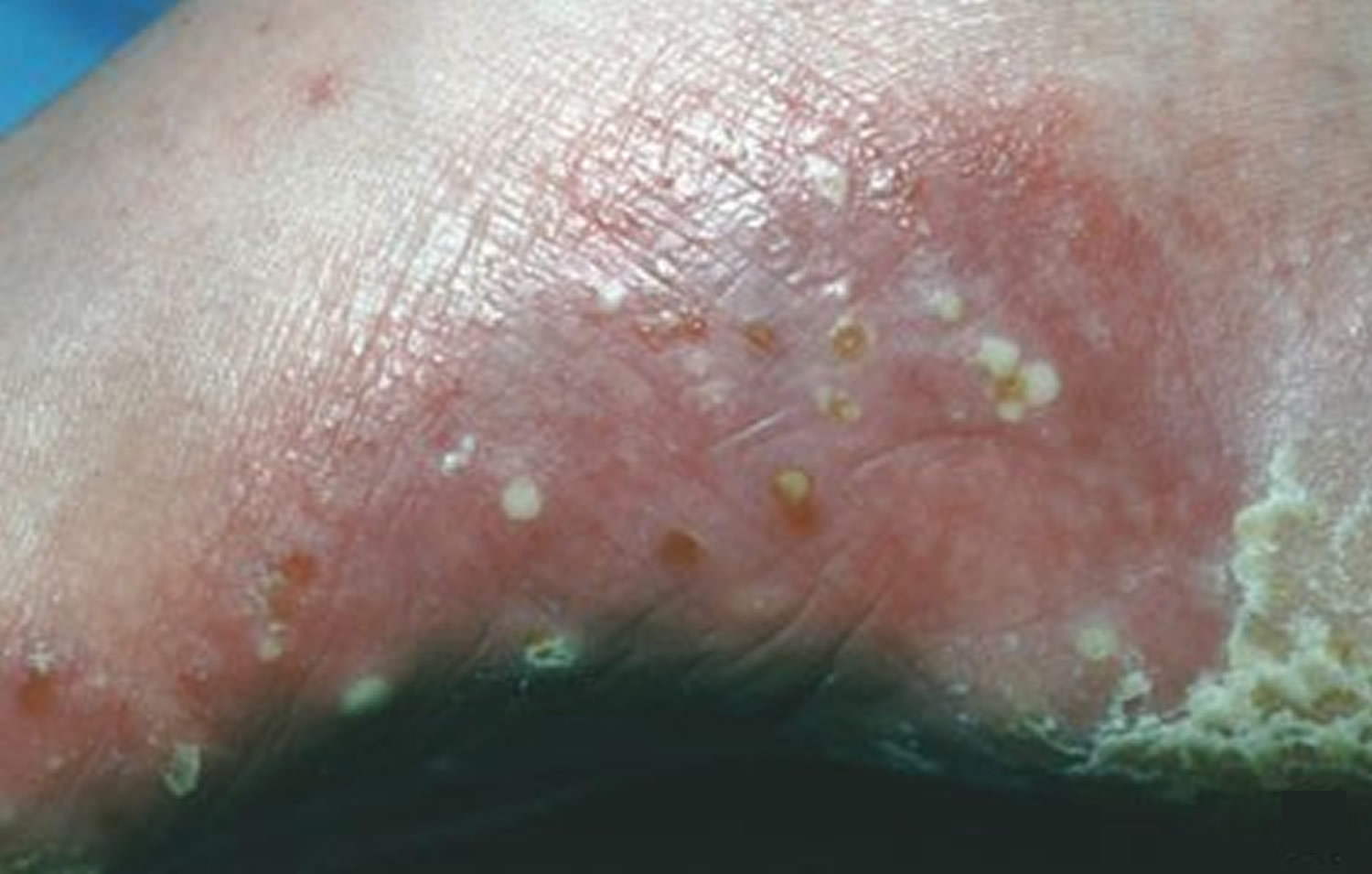Contents
What is pustular psoriasis
Pustular psoriasis is a severe form of a skin disorder called psoriasis. Pustular psoriasis is characterized by white pustules (blisters of noninfectious pus) surrounded by red skin 1. The pus consists of white blood cells. It is not an infection, nor is it contagious.Pustular psoriasis and other forms of psoriasis are caused by immune-mediated skin disease that causes itchy or sore patches of thick, raised, red skin with silvery scales to appear on the skin 2. Inflammation is a normal immune system response to injury and foreign invaders (such as bacteria). However, when inflammation is abnormal and uncontrolled, it can damage the body’s tissues and organs. Individuals with pustular psoriasis have repeated episodes in which large areas of skin become red and inflamed and develop small pus-filled blisters (pustules). The skin problems can be accompanied by fever, extreme tiredness (fatigue), muscle weakness, an increased number of white blood cells, and other signs of inflammation throughout the body (systemic inflammation). The inflammation problems subside and reappear often. Episodes can be triggered by infection, exposure to or withdrawal from certain medications, menstruation, or pregnancy, although the trigger is often unknown. Generalised pustular psoriasis can be life-threatening if not treated.
- People with generalised pustular psoriasis should be referred immediately for same-day specialist assessment and treatment.
While many affected individuals have features only of generalised pustular psoriasis (called generalised pustular psoriasis alone), some develop features of another skin condition called plaque psoriasis (psoriasis vulgaris), either before or after generalised pustular psoriasis appears. Plaque psoriasis, the most common form of psoriasis, is characterized by red, scaly patches of skin (plaques) on parts of the body.
Types of Pustular Psoriasis
Von Zumbusch pustular psoriasis
Von Zumbusch pustular psoriasis can appear abruptly on the skin. It is characterized by widespread areas of reddened skin, which become painful and tender. Within hours, the pustules appear. Over the next 24 to 48 hours, the pustules dry, leaving the skin with a glazed and smooth appearance. Children rarely develop Von Zumbusch pustular psoriasis, but when it does happen it is often the first psoriasis flare and may have a better outcome than in adults. Von Zumbusch pustular psoriasis is associated with fever, chills, severe itching, dehydration, a rapid pulse rate, exhaustion, anemia, weight loss and muscle weakness.
- Von Zumbusch pustular psoriasis can be life-threatening and requires immediate medical care. People with von Zumbusch pustular psoriasis often need to be hospitalized for rehydration and start topical and systemic treatment, which typically includes antibiotics.
Palmoplantar pustular psoriasis
Palmoplantar pustular psoriasis causes pustules on the palms of the hand and soles of the feet. It commonly affects the base of the thumb and the sides of the heels. Pustules initially appear in a studded pattern on top of red plaques of skin, but then turn brown, peel and become crusted. Palmoplantar pustular psoriasis is usually cyclical, with new crops of pustules followed by periods of low activity.
Acropustulosis
Acropustulosis (acrodermatitis continua of Hallopeau) is a rare type of psoriasis characterized by skin lesions on the ends of the fingers and sometimes on the toes. The eruption occasionally starts after an injury to the skin or infection. The lesions can be painful and disabling, and cause deformity of the nails. Occasionally bone changes occur in severe cases.
Figure 1. Palmoplantar pustular psoriasis

Symptoms of Pustular psoriasis
Pustular psoriasis is primarily seen in adults. It may be limited to certain areas of the body — for example, the hands and feet. Generalized pustular psoriasis also can cover most of the body. It tends to go in a cycle with reddening of the skin followed by pustules and scaling.
Triggers for Pustular psoriasis
A number of factors may trigger pustular psoriasis, including:
- Internal medications
- Irritating topical agents
- Overexposure to UV light
- Pregnancy
- Systemic steroids
- Infections
- Emotional stress
- Sudden withdrawal of systemic medications or potent topical steroids.
Treatment of pustular psoriasis
It is not unusual for doctors to combine or rotate treatments for pustular psoriasis due to the potential side effects of systemic medications and phototherapy. More than one study indicates a combination of acitretin (brand name Soriatane) and methotrexate can send pustular psoriasis into rapid remission and eventual clear the skin; however these medications do not need to be combined to be effective for pustular psoriasis. Treatments for specific types of pustular psoriasis include:
- Generalized pustular psoriasis: The goal of treatment is to prevent infection and fluid loss, stabilize the body’s temperature and restore the skin’s chemical balance. Acitretin, cyclosporine, methotrexate, oral PUVA (the light-sensitizing drug psoralen plus ultraviolet light A) and TNF-alpha blockers, such as infliximab, are often prescribed.
- Localized pustular psoriasis: This form can be stubborn to treat. Topical treatments are usually prescribed first. Your doctor may prescribe PUVA, ultraviolet light B (UVB), acitretin, methotrexate or cyclosporine.
- Von Zumbusch pustular psoriasis: Treatment often consists of acitretin, cyclosporine or methotrexate. Some doctors may prescribe oral steroids for those who do not respond to other treatments or who have become very ill, but their use is controversial because sudden withdrawal of steroids can trigger von Zumbusch pustular psoriasis. PUVA may be used once the severe stage of pustule development and redness has passed.
- Palmoplantar pustular psoriasis: Because PP often is stubborn to treat, doctors usually prescribe topical treatments first, and then consider other options, including PUVA, UVB, acitretin, methotrexate or cyclosporine.
- Acropustulosis: Traditionally this form of pustular psoriasis has been hard to treat. Occlusion of topical preparations may help some people. Some people have had success using systemic medications to clear lesions and restore the nails.
Prognosis
Psoriasis is a chronic (long-lasting) disease of the immune system. It cannot be cured. This means that most people have psoriasis for life. Pustular psoriasis flare-ups that may be painful and disabling.




